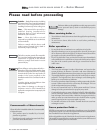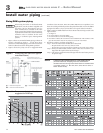
Part number 550-100-026/0404
GAS-FIRED WATER BOILER SERIES 2 — Boiler Manual
12
Install water piping
3
Install relief valve
1. Install relief valve in ¾" street elbow piped from boiler
supply piping tee (Figure 3, page 11). Pipe the relief
valve only as shown, in the location shown.
2. Connect discharge piping to safe disposal location,
following guidelines in the WARNING below.
To avoid water damage or scalding due to
relief valve operation:
• Discharge line must be connected to relief
valve outlet and run to a safe place of
disposal. Terminate the discharge line in a
manner that will prevent possibility of
severe burns or property damage should
the valve discharge.
• Discharge line must be as short as possible
and be the same size as the valve discharge
connection throughout its entire length.
• Discharge line must pitch downward from
the valve and terminate at least 6" above
the floor drain where any discharge will be
clearly visible.
• The discharge line shall terminate plain, not
threaded, with a material serviceable for
temperatures of 375 °F or greater.
• Do not pipe the discharge to any place
where freezing could occur.
• No shutoff valve shall be installed between
the relief valve and boiler, or in the discharge
line. Do not plug or place any obstruction
in the discharge line.
• Test the operation of the valve after filling
and pressurizing system by lifting the lever.
Make sure the valve discharges freely. If the
valve fails to operate correctly, replace it
with a new relief valve.
• Failure to comply with the above guidelines
could result in failure of the relief valve to
operate, resulting in possibility of severe
personal injury, death or substantial
property damage.
General piping information
Additional controls, when required
The Ultra control module uses
temperature sensors to provide both high
limit protection and modulating
temperature control. The control module
also provides low water protection by
sensing the temperature of the heat
exchanger. Some codes/jurisdictions may
require additional external controls for
high limit and/or low water cutoff
protection.
Additional limit control:
Following standard industry practices, if installation is
to comply with ASME or Canadian requirements, an
additional high temperature limit is needed. Consult local
requirements for other codes/standards to determine if
needed.
1. Install additional high temperature limit constructed
to prevent a temperature setting above 200°F in system
supply piping between boiler and isolation valve.
(Note that the Ultra control module operating limit
function shuts the boiler down at 190°F or Parameter
4, whichever is lower.)
2. See Ultra Control Supplement for wiring.
a. If limit control is to cause a boiler hard lockout (requiring
manual reset of Ultra control module), connect isolated
contact to field control wiring terminals 6 and 8 as
shown in wiring diagram.
b. Otherwise, connect isolated contact between
terminals 6 and 7 for a soft lockout (automatic reset).
c. If using a manual reset limit control or wiring in the
manual reset circuit, Parameter 4 should be no closer
than 20°F to the limit control setting (i.e., no higher
than 180°F for a 200°F limit setting, for example).
Separate low water cutoff:
A low water cutoff device is required when boiler is
installed above piping level or by certain state or local
codes or insurance companies. Consult local
requirements to determine.
1. If required, use a low water cutoff designed for water
installations. Electrode probe-type is recommended.
2. Purchase low water cutoff and install in tee in supply
piping above boiler.
3. See Ultra Control Supplement for wiring.
a. If limit control is to cause a boiler hard lockout (requiring
manual reset of Ultra control module), connect isolated
contact to field control wiring terminals 6 and 8 as
shown in wiring diagram.
b. Otherwise, connect isolated contact between
terminals 6 and 7 for a soft lockout (automatic reset).
Backflow preventer:
Use backflow check valve in cold water supply as required
by local codes.
Use two wrenches when tightening water
piping at boiler, using one wrench to
prevent the boiler return line or supply line
from turning. Failure to support the boiler
piping connections to prevent them from
turning could cause damage to boiler
components.


















